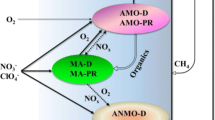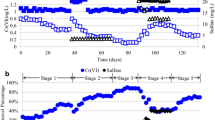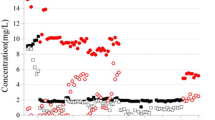Abstract
Chromate can be reduced by methanotrophs in a membrane biofilm reactor (MBfR). In this study, we cultivated a Cr(VI)-reducing biofilm in a methane (CH4)-based membrane biofilm batch reactor (MBBR) under anaerobic conditions. The Cr(VI) reduction rate increased to 0.28 mg/L day when the chromate concentration was ≤ 2.2 mg/L but declined sharply to 0.01 mg/L day when the Cr(VI) concentration increased to 6 mg/L. Isotope tracing experiments showed that part of the 13C-labeled CH4 was transformed to 13CO2, suggesting that the biofilm may reduce Cr(VI) by anaerobic methane oxidation (AnMO). Microbial community analysis showed that a methanogen, i.e., Methanobacterium, dominated in the biofilm, suggesting that this genus is probably capable of carrying out AnMO. The abundance of Methylomonas, an aerobic methanotroph, decreased significantly, while Meiothermus, a potential chromate-reducing bacterium, was enriched in the biofilm. Overall, the results showed that the anaerobic environment inhibited the activity of aerobic methanotrophs while promoting AnMO bacterial enrichment, and high Cr(VI) loading reduced Cr(VI) flux by inhibiting the methane oxidation process.





Similar content being viewed by others
References
Ackerley DF, Gonzalez CF, Keyhan M, Blake R II, Matin A (2010) Mechanism of chromate reduction by the Escherichia coli protein, NfsA, and the role of different chromate reductases in minimizing oxidative stress during chromate reduction. Environ Microbiol 6:851–860
Barnhart J (1997) Occurrences, uses, and properties of chromium. Regul Toxicol Pharmacol 26:3–7
Cakir FY, Stenstrom MK (2005) Greenhouse gas production: a comparison between aerobic and anaerobic wastewater treatment technology. Water Res 39(17):4197–4203
Diederik JO, Lizelle AP, Esta VH (2008) A novel chromate reductase from Thermus scotoductus SA-01 related to old yellow enzyme. J Bacteriol 190:3076–3082
Dragun J (1988) The soil chemistry of hazardous materials. Hazardous Materials Control Research Institute, Silver Spring
Ettwig KF, Butler MK, Paslier DL, Pelletier E, Mangenot S, Kuypers MMM, Schreiber F, Dutilh BE, Zedelius J, De Beer D (2010) Nitrite-driven anaerobic methane oxidation by oxygenic bacteria. Nature 464:543–548
Garcia EA, Gomis DB (1997) Speciation analysis of chromium using crypt and ethers. Analyst 122:899–902
Haroon MF, Hu S, Shi Y, Imelfort M, Keller J, Hugenholtz P, Yuan Z, Tyson GW (2013) Anaerobic oxidation of methane coupled to nitrate reduction in a novel archaeal lineage. Nature 500:567–570
Hu BL, Shen LD, Lian X, Zhu Q, Liu S, Huang Q, He ZF, Geng S, Cheng DQ, Lou LP, Xu XY, Zheng P, He YF (2014) Evidence for nitrite-dependent anaerobic methane oxidation as a previously overlooked microbial methane sink in wetlands. Proc Natl Acad Sci U S A 111:4495–4500
Kantar C, Cetin Z, Demiray H (2008) In situ stabilization of chromium(VI) in polluted soils using organic ligands: the role of galacturonic, glucuronic and alginic acids. J Hazard Mater 159:287–293
Kathiravan MN, Karthick R, Muthukumar K (2011) Ex situ bioremediation of Cr(VI) contaminated soil by Bacillus sp.: batch and continuous studies. Chem Eng J 169:107–115
Knittel K, Losekann T, Boetius A, Kort R, Amann R (2005) Diversity and distribution of methanotrophic archaea at cold seeps. Appl Environ Microbiol 71:467–479
Lai CY, Yang X, Tang YN, Rittmann BE, Zhao HP (2014) Nitrate shaped the selenate-reducing microbial community in a hydrogen-based biofilm reactor. Environ Sci Technol 48:3395–3402
Lai CY, Wen LL, Zhang Y, Luo SS, Wang QY, Luo YH, Chen R, Yang X, Rittmann BE, Zhao HP (2016a) Autotrophic antimonate bio-reduction using hydrogen as the electron donor. Water Res 88:467–474
Lai CY, Zhong L, Zhang Y, Chen JX, Wen LL, Shi LD, Sun YP, Ma F, Rittmann BE, Zhou C, Tang YN, Zheng P, Zhao HP (2016b) Bioreduction of chromate in a methane-based membrane biofilm reactor. Environ Sci Technol 50:5832–5839
Lai CY, Dong QY, Chen JX, Zhu QS, Yang X, Chen WD, Zhao HP, Zhu L (2018a) Role of extracellular polymeric substances in a methane based membrane biofilm reactor reducing vanadate. Environ Sci Technol 52:10680–10688
Lai CY, Dong QY, Rittmann BE, Zhao HP (2018b) Bioreduction of antimonate by anaerobic methane oxidation in a membrane biofilm batch reactor. Environ Sci Technol 52:8693–8700
Lai CY, Lv PL, Dong QY, Yeo SL, Rittmann B, Zhao HP (2018c) Bromate and nitrate bioreduction coupled with poly-β-hydroxybutyrate production in a methane-based membrane biofilm reactor. Environ Sci Technol 52:7024–7031
Lovley DR, Coates JD (1997) Bioremediation of metal contamination. Curr Opin Biotechnol 8:285–289
Lu YZ, Fu L, Ding J, Ding ZW, Li N, Zeng RJ (2016) Cr(VI) reduction coupled with anaerobic oxidation of methane in a laboratory reactor. Water Res 102:445–452
Luo J, Chen H, Hu S, Cai C, Yuan ZG, Guo JH (2018) Microbial selenate reduction driven by a denitrifying anaerobic methane oxidation biofilm. Environ Sci Technol 52:4006–4012
Lv PL, Zhong L, Dong QY, Yang SL, Shen WW, Zhu QS, Lai CY, Luo AC, Tang Y, Zhao HP (2018) The effect of electron competition on chromate reduction using methane as electron donor. Environ Sci Pollut Res 25(7):6609–6618
Lv PL, Shi LD, Wang Z, Rittmann BE, Zhao HP (2019) Methane oxidation coupled to perchlorate reduction in a membrane biofilm batch reactor. Sci Total Environ 667:9–15
Maeda H, Fujimoto C, Haruki Y, Maeda T, Kokeguchi S, Petelin M, Arai H, Tanimoto I, Nishimura F and Takashiba S, (2003) Quantitative real-time PCR using TaqMan and SYBR Green for Actinobacillus actinomycetemcomitans, Porphyromonas gingivalis, Prevotella intermedia, tetQ gene and total bacteria. FEMS Immunology & Medical Microbiology, 39(1):81–86
Martin KJ, Nerenberg R (2012) The membrane biofilm reactor (MBfR) for water and wastewater treatment: principles, applications, and recent developments. Bioresour Technol 122:83–94
Meyer KJ, Swaim P D, Bellamy WD, Rittmann BE, Tang YN, Scott R (2010) Biological and ion exchange nitrate removal: performance and sustainability evaluation, Final Project Report, Water Research Foundation: Denver, CO
Modin O, Fukushi K, Yamamoto K (2007) Denitrification with methane as external carbon source. Water Res 41:2726–2738
Moran JJ, House CH, Freeman KH, Ferry JG (2014) Trace methane oxidation studied in several euryarchaeota under diverse conditions. Archaea 5:303
Orphan VJ, House CH, Hinrichs KU, Mckeegan KD, Delong EF (2001) Methane-consuming archaea revealed by directly coupled isotopic and phylogenetic analysis. Science 293:484–487
Rittmann, McCarty (2002) Environmental biotechnology: principles and applications. McGraw-Hill
Sahinkaya E, Kilic A, Calimlioglu B, Toker Y (2013) Simultaneous bioreduction of nitrate and chromate using sulfur-based mixotrophic denitrification process. J Hazard Mater 262:234–239
Smith WA, Apel WA, Petersen JN, Peyton BM (2002) Effect of carbon and energy source on bacterial chromate reduction. Bioremediat J 6:205–215
Sun Y, Wolcott RD, Dowd SE (2011) Tag-encoded FLX amplicon pyrosequencing for the elucidation of microbial and functional gene diversity in any environment. In: Kwon Y, Ricke S (eds) High-throughput next generation sequencing. Methods in molecular biology (Methods and Protocols) 733. Humana Press, Totowa
Viamajala S, Peyton BM, Sani RK, Apel WA, Petersen JN (2008) Toxic effects of chromium(VI) on anaerobic and aerobic growth of Shewanella oneidensis MR-1. Biotechnol Prog 20:87–95
Wang DB, Wang YL, Liu YW, Ngo HH, Lian Y, Zhao JW, Chen F, Yang Q, Zeng GM, Li XM (2017a) Is denitrifying anaerobic methane oxidation-centered technologies a solution for the sustainable operation of wastewater treatment Plants? Bioresour Technol 234:456–465
Wang GY, Zhang BG, Li S, Yang M, Yin CC (2017b) Simultaneous microbial reduction of vanadium (V) and chromium (VI) by Shewanella loihica PV-4. Bioresour Technol 227:353–358
Wang S, Zhang BG, Diao MH, Shi JX, Jiang YF, Cheng YT, Liu H (2018) Enhancement of synchronous bio-reductions of vanadium (V) and chromium (VI) by mixed anaerobic culture. Environ Pollut 242:249–256
World Health Organization (2011) Guidelines for drinking-water quality, 4th edn. WHO Press, Geneva
Zahoor A, Rehman A (2009) Isolation of Cr(VI) reducing bacteria from industrial effluents and their potential use in bioremediation of chromium containing wastewater. J Environ Sci China 21:814–820
Zehnder AJB, Brock TD (1979) Methane formation and methane oxidation by methanogenic bacteria. J Bacteriol 137:420–432
Zhang BG, Feng CP, Ni JR, Zhang J, Huang WL (2013) Simultaneous reduction of vanadium (V) and chromium (VI) with enhanced energy recovery based on microbial fuel cell technology. J Power Sources 204:34–39
Zhong L, Lai CY, Shi LD, Wang KD, Dai YJ, Liu YW, Ma F, Rittmann BE, Zheng P, Zhao HP (2017) Nitrate effects on chromate reduction in a methane-based biofilm. Water Res 115:130–137
Zhou Y, Guo H, Lu H, Mao R, Zheng H, Wang J (2015) Analytical methods and application of stable isotopes in dissolved organic carbon and inorganic carbon in groundwater. Rapid Commun Mass Spectrom 29:1827–1835
Funding
The authors greatly thank the National Natural Science Foundation of China (grant nos. 21577123, 51878596) and Natural Science Funds for Distinguished Young Scholar of Zhejiang Province (LR17B070001) for their financial support.
Author information
Authors and Affiliations
Corresponding authors
Additional information
Responsible editor: Gerald Thouand
Publisher’s note
Springer Nature remains neutral with regard to jurisdictional claims in published maps and institutional affiliations.
Electronic supplementary material
ESM 1
(DOCX 197 kb)
Rights and permissions
About this article
Cite this article
Dong, QY., Wang, Z., Shi, LD. et al. Anaerobic methane oxidation coupled to chromate reduction in a methane-based membrane biofilm batch reactor. Environ Sci Pollut Res 26, 26286–26292 (2019). https://doi.org/10.1007/s11356-019-05709-7
Received:
Accepted:
Published:
Issue Date:
DOI: https://doi.org/10.1007/s11356-019-05709-7




